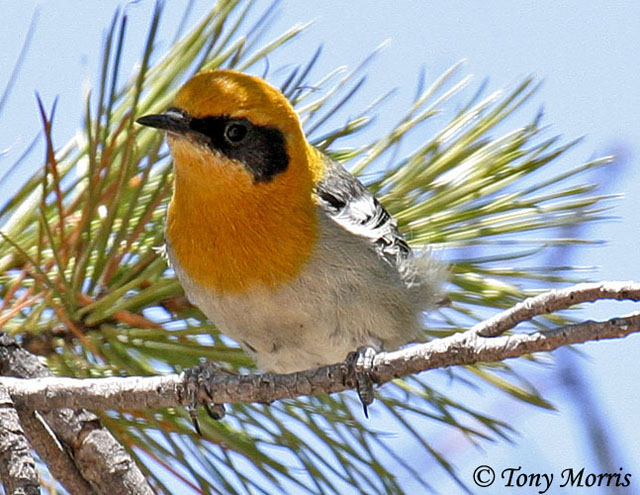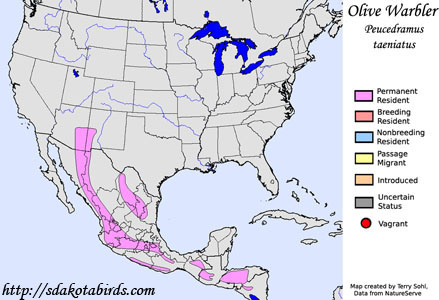| Length: 5.25 inches | Wingspan: 9 inches | Seasonality: Non-resident in South Dakota |
| ID Keys: Gray back, dark wings with 2 obvious white wing bars. Males have an orangish head and breast and black facial mask. Females more yellowish on head and breast and have a less distinct facial mask. | ||
 The
Olive Warbler is a small passerine, with most of the species' range found in
Mexico and Central America. In the United States, they are found in
montane forests of southeast Arizona and southwest New Mexico. The scientific name is translated as "Pine Runner", an appropriate title
given their preference for evergreen forest (particularly Ponderosa Pine),
and active foraging behavior While somewhat similar in structure to
the numerous Wood Warbler species of North America, research has discovered a unique
heritage, and Olive Warblers are now found in their own family. While
they are sometimes rather easily found, even in their limited range in the
U.S., many of their habits and behaviors are poorly known, given their
preference for the higher portions of the forest canopy. .
The
Olive Warbler is a small passerine, with most of the species' range found in
Mexico and Central America. In the United States, they are found in
montane forests of southeast Arizona and southwest New Mexico. The scientific name is translated as "Pine Runner", an appropriate title
given their preference for evergreen forest (particularly Ponderosa Pine),
and active foraging behavior While somewhat similar in structure to
the numerous Wood Warbler species of North America, research has discovered a unique
heritage, and Olive Warblers are now found in their own family. While
they are sometimes rather easily found, even in their limited range in the
U.S., many of their habits and behaviors are poorly known, given their
preference for the higher portions of the forest canopy. .
Habitat: Found in montane evergreen forests, usually at relatively high elevations of 5,000 feet or more. During the winter, small numbers may be found in lower-elevation forests, including some use of deciduous (oak) forests.
Diet: Feeds mostly on insects and spiders.
Behavior: Olive Warblers typically forage rather high in the forest canopy. They will often forage in mixed species flocks, particularly outside of the breeding season. Moves rather actively as they feed, often flicking their wings as the forage.
Nesting: The nest of an Olive Warbler is a small cup of mosses, pine needles, and lichen, lined with softer plant material. The female lays 3 or 4 eggs, and upon hatching, both parents help to feed the young.
Song: The song of an Olive Warbler is a series of rapidly repeated whistles.
Migration: Considered a permanent resident throughout their much of their range. However, at least some of those in the United States are only summer residents. Smaller numbers are still found in the winter in the U.S.
Interactive eBird Map: Click here to access an interactive eBird map of Olive Warbler sightings
Similar Species: Rather distinctive if seen well, but in range, females especially could possibly be confused with Verdin or Hermit Warbler.
Conservation Status: Populations may be in decline, but they are still spread over a wide geographic region and are relatively common in some parts of their range. The IUCN lists the Olive Warbler as a species of "Least Concern".
Further Information: 1) WhatBird - Olive Warbler
2) Audubon Guide - Olive Warbler
3) BirdLife International - Olive Warbler
Photo Information: Photo taken by Tony Morris - May 19th, 2006 - Paradise, Arizona - Photo licensed under Creative Commons Attribution 2.0 Generic License.
| Click below for a higher-resolution map |
 |
| South Dakota Status: Non-resident in South Dakota |
Additional Olive Warbler Photos (coming soon!!)
